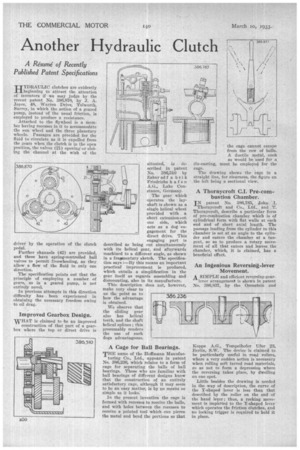Another Hydraulic
Page 68

If you've noticed an error in this article please click here to report it so we can fix it.
A Resume of Recently Published Patent Specifications JJYDRAULIC clutches are evidently _beginning to attract the attention of inventors if we may judge by the recent patent No. 386,870, by J. A. Joyce, 48, Warren Drive, Tolworth, Surrey, in which the action of a geared pump, instead of the usual friction, is employed to produce a resistance.
Attached to the flywbeel is a member having recesses in it to accommodate the sun wheel and the three planetary wheels. Passages are provided for the fluid to circulate as it is expelled from the gears when the clutch is in the open position, the valves (21) opening or cloging the channel at the wish of the driver by pedal. the operation of the clutch Further channels (42) are provided, and these have spring-controlled ball valves to permit freewheeling, as they allow a flow of the fluid in only one direction.
The specification points out that the principle of employing a number of gears, as in a geared pump, is not entirely novel.
In previous attempts in this direction difficulty has been experienced in obtaining the necessary freedom owing to oil drag.
Improved Gearbox Design.
WHAT is claimed to be an improved construction of that part of a gearbox where the top or direct drive is situated, is described in patent No. 386,510 by Zahnr ad f a brik Priedrichs haf en A.G., Lake Constance; Germany.
The gear which operates the layshaft is shown as a single helical wheel provided with a short extension one side, which acts as a dog en
_ gagement for the
direct drive. This engaging part is described as being cut simultaneously with its helical gear, and afterwards machined to a different angle, as shown in a fragmentary sketch. The specification says :—By this means an important practical improvement is produced, which entails a simplification in the gear itself as regards assembling and dismounting, also in its manufacture.
This description does not, however, make very clear to us the point as to how the advantage is obtained.
We observe that the sliding gear also has helical teeth, and the shaft helical splines ; this presumably renders the use of such dogs advantageous.
A Cage for Ball Bearings.
THE name of the Hoffmann Manufac turing Co., Ltd., appears in patent No. 386,236, which relates to a form of cage for separating the balls of ball bearings. Those who are familiar with ball bearings of different designs know that the construction of an entirely satisfactory cage, although it may seem to be an easy matter, is by no means so simple as it looks.
In the present invention the cage is formed with recesses to receive the balls, and with holes between the recesses to receive a pointed tool which can pierce the metal and bend the portions so that the cage cannot escape from the row of balls. A ductile metal, such as would be used for a, die-casting, must be employed for the cage.
The drawing shows the cage in a Straight line, for clearness, the figure on the left being a sectional view.
A Thornycroft C.I. Pre-combustion Chamber.
IN patent No. 386,785, John. I. Thornycroft and Co., Ltd., and T. Thornycroft, describe a particular form of pre-combustion chamber which is of cylindrical form with fiat walls at each end and of short axial length. The passage leading from the cylinder to this Chamber is set at an angle to the cylinder and enters the chamber at a tangent, so as to produce a rotary movement of all that enters and leaves the chamber, which, it is claimed, has a beneficial effect.
An Ingenious Reversing-lever Movement.
A SIMPLE and efficient reversing-gearlever arrangement is shown in patent No. 386,837, by the Orenstein and
Koppe A.G., Tempelhofer Ufer 23, Berlin, S.W. The device is claimed to be particularly useful in road rollers, where a very sudden action'is necessary when rolling soft tarred road materials, so as not to' form a depression where the reversing takes place, by dwelling on one spot.
Little besides the drawing is needed in the way of description, the curve of the Y-shaped lever is less than that described by the roller on the end of the hand lever ; thus, a rocking movement is imparted to the Y-shaped lever which operates the friction clutches, and no locking trigger is required to hold it in place.






































































































